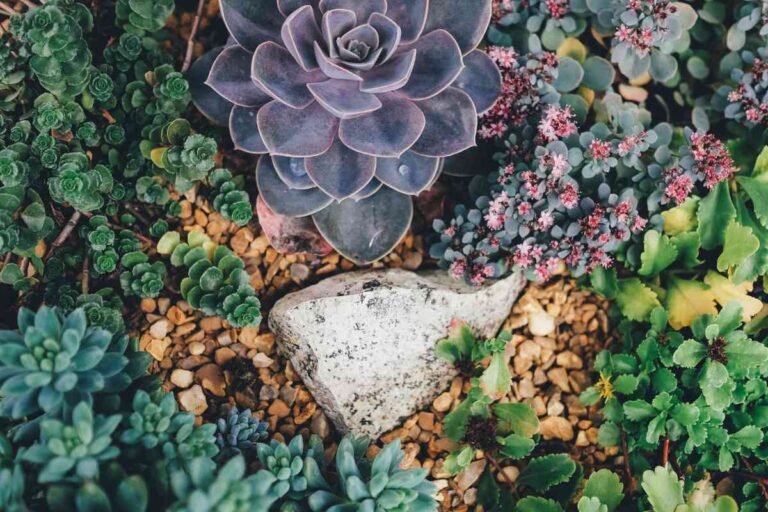What Animals Eat Succulents: A Comprehensive Guide
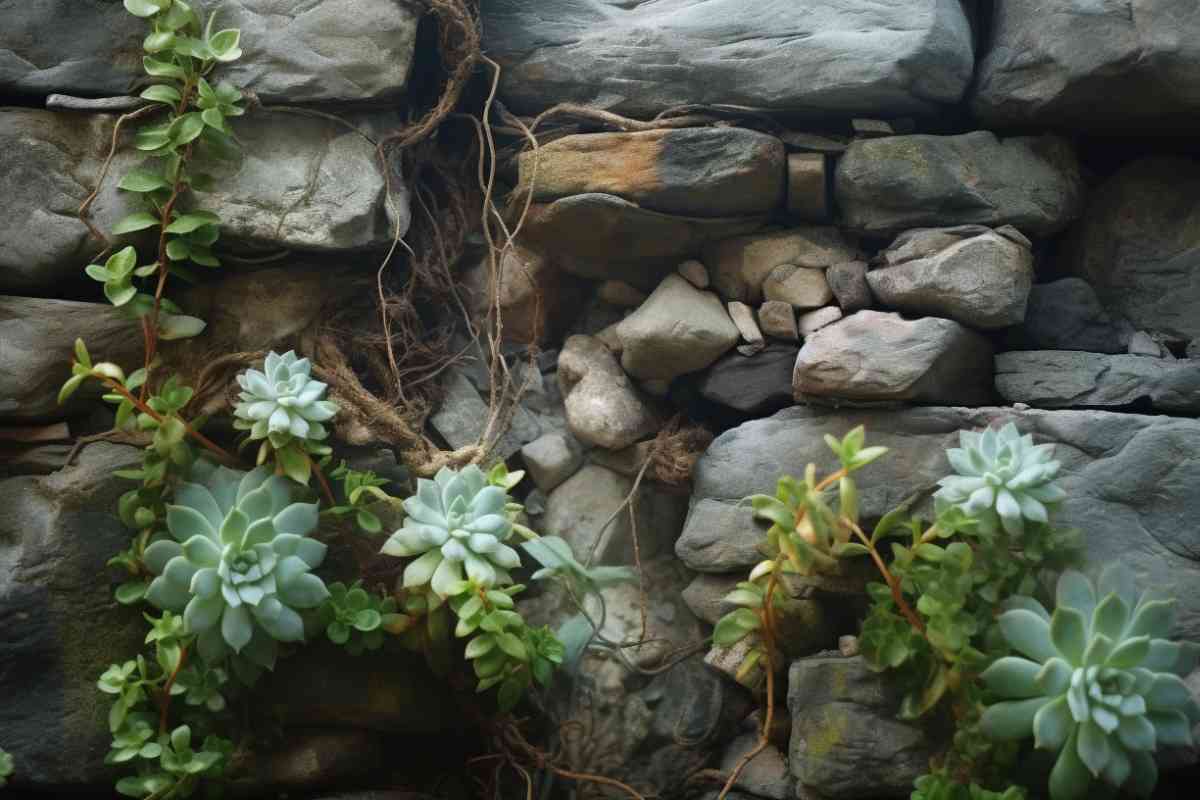
You’ve lovingly curated your succulent collection, basking in the beauty of those plump leaves and quirky shapes. But lo and behold, you discover that some sneaky critters have been indulging in an all-you-can-eat buffet of your gorgeous plants! How rude!
Now, before you throw your gardening gloves in frustration, fear not, for I, your trusty succulent expert, am here to save the day. After years of battling munching menaces, I’ve honed my skills in identifying the culprits and defending our beloved succulents from their hungry appetites.

What Animals Eat Succulents?
While succulents are pretty tough, animals do find ways to eat them. Mammals like mice and rabbits, insects like slugs and mealybugs, birds like crows and pigeons, and reptiles like tortoises and iguanas all enjoy munching on succulents
Here’s what you need to know about the animals that might be eating your succulents.
Have pesky critters left your succulents without roots? Here’s how to save succulents without roots.
Want a succulent arrangement that will stay safe from critters? This hanging terrarium succulent planter is a safe place for your precious succulents.
Overview of Animals That Eat Succulents
Mammals
Mammals are the most common animals that eat succulents. They include rodents, rabbits, deer, chipmunks, ground squirrels, gophers, prairie dogs, and goats. These animals are known to chew on succulent leaves and stems, causing damage and sometimes even killing the plants.
Cats and dogs are also known to occasionally nibble on succulents, but they are not as destructive as other mammals.
Birds
Birds like sparrows, finches, crows, and pigeons are attracted to succulents because of their juicy leaves and stems. Birds can cause significant damage to succulent plants, especially if they are part of a flock.
Insects
Insects are a significant threat to succulent plants. They include grasshoppers, mealybugs, caterpillars, and spider mites. These insects feed on the leaves and stems of succulent plants, causing wilting and discoloration.
Reptiles
Reptiles are not as common as other animals that eat succulents, but they still pose a threat, especially in places where exotic reptiles are invasive. Tortoises are known to eat succulents, especially the Opuntia cactus. They are attracted to the juicy pads of the cactus. Iguanas eat pretty much every part of the succulent.
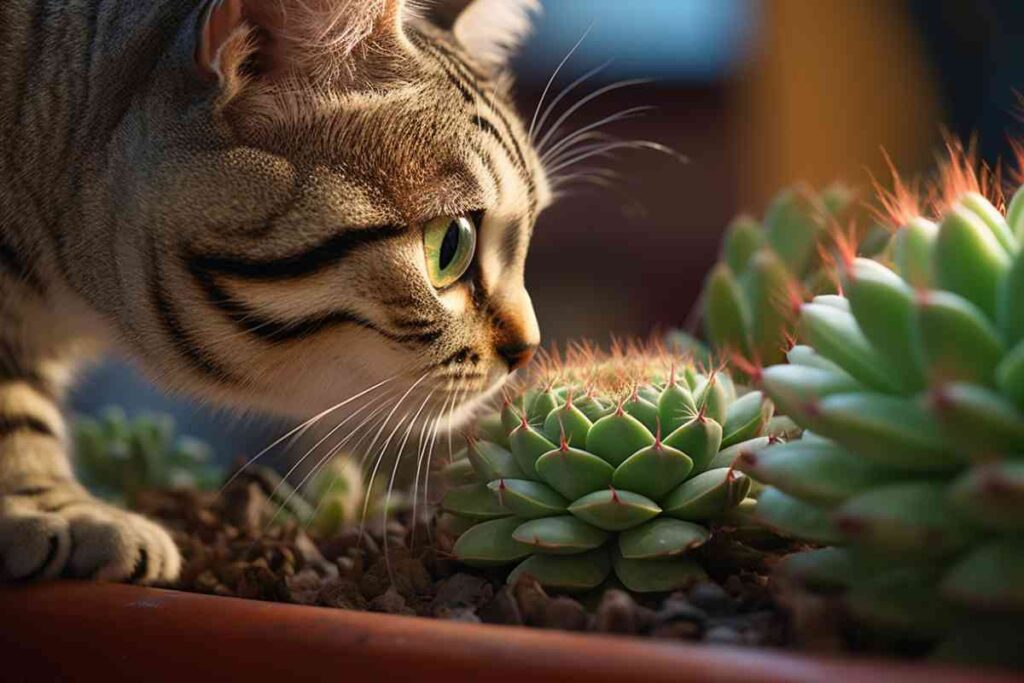
Signs of Animal Infestation
- Jagged tear marks: If you see jagged tear marks on your succulent leaves or stems, it could be a sign that an animal is eating your plants. These marks are typically caused by animals with sharp teeth, such as squirrels, rats, or rabbits.
- Uprooted plants: Succulents uprooted or pulled out of the ground, is likely a result of an animal digging up your plants in search of food. Animals such as raccoons, skunks, and possums are known to dig up succulents.
- Chewed up leaves: If you see leaves that have been chewed up or partially eaten, it could be a sign that an animal is eating your succulents. Animals such as rabbits, deer, and squirrels are known to eat succulent leaves.
- Deep wounds: If you see deep wounds on your succulent stems, it could be a sign that an animal is using your plants as a nesting site. Animals such as birds and rodents may create nests in your succulents, causing damage to the plant.
- Poop: If you see animal droppings near your succulents, it is a clear sign that an animal has been eating your plants. You can use the appearance of the poop to identify the type of animal that is eating your succulents.
General Preventative Measures
Preventing animals from eating your succulents is crucial to keeping them healthy and thriving. Here are some general effective preventative measures you can take to keep animals away from your succulents.
Distractions
Deterrents are a great way to keep animals from eating your succulents. Some effective deterrents include:
- Bird feeders and waterers: Birds are less likely to eat your succulents if they have a nearby food and water source.
- Scarecrows: Scarecrows can help keep birds and other animals away from your succulents.
Physical Barriers
Physical barriers are another effective way to keep animals from eating your succulents. Some physical barriers include:
- Netting: Bird netting can be used to keep birds away from your succulents.
- Fencing: Fencing can be a great way to keep larger animals like deer and rabbits away from your succulents.
- Rocks: Placing rocks around your succulents can make it difficult for animals to get to them.
- Spikes: Spikes can be placed around your succulents to keep animals from getting too close.
Animal Repellents
There are many animal repellents on the market that can be used to keep animals away from your succulents. Some effective animal repellents include:
- Mothballs: Mothballs can be used to keep animals away from your succulents.
- Predator urine: The scent of predator urine can deter animals from entering your garden.
- Bird deterrents: There are many bird deterrents on the market that can be used to keep birds away from your succulents.
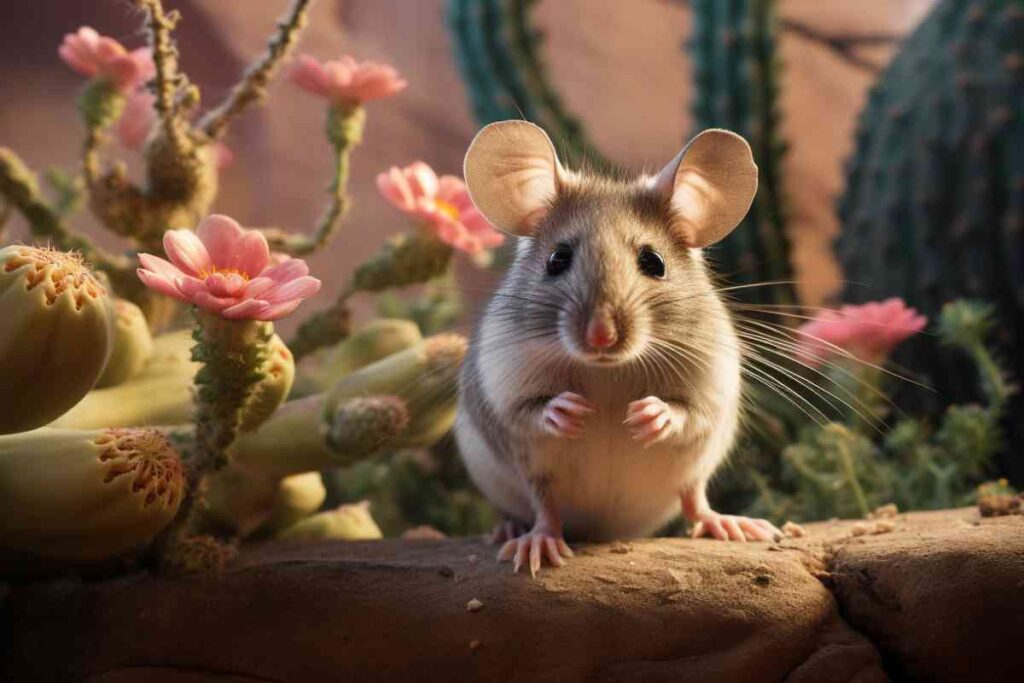
Top 10 Mammals that Eat Succulents and What to do About It
- Pigs:
- Description: Pigs, including domestic and feral pigs, are large mammals with stout bodies and a keen sense of smell.
- Damage: Pigs can uproot succulents, dig in the soil, and consume entire plants, causing severe damage to garden beds.
- Ways to Deter Them:
- Install sturdy fencing around the garden or individual succulent beds to prevent pigs from accessing the area.
- Use motion-activated sprinklers or noise deterrents to startle and deter pigs from approaching the garden.
- Apply organic repellents such as chili pepper spray or garlic-based solutions to make the succulents unappealing to pigs.
- If dealing with feral pigs, consult with local wildlife authorities or pest control professionals for proper management techniques.
- Consider using electric fencing as an effective deterrent for both domestic and feral pigs.
- Goats:
- Description: Goats are domesticated mammals known for their ability to eat a variety of vegetation, including succulent leaves.
- Damage: Goats can browse on succulent foliage, causing significant damage to plants, especially at lower heights.
- Ways to Deter Them:
- Install strong fencing around the garden or individual succulent beds, ensuring it is goat-proof with no gaps or loose sections.
- Utilize motion-activated sprinklers or noise deterrents like wind chimes or banging objects to deter goats from approaching the garden.
- Plant goat-resistant species or varieties of succulents that are less palatable to goats.
- Apply organic repellents such as strong-smelling substances like predator urine or garlic sprays to make the succulents unappealing to goats.
- If dealing with stray or wandering goats, contact local authorities or the owner to address the issue.
- Rabbits:
- Description: Rabbits are small mammals known for their long ears, hopping gait, and ability to reproduce rapidly.
- Damage: Rabbits can graze on succulent leaves and stems, causing extensive damage and potentially killing the plants.
- Ways to Deter Them:
- Install physical barriers such as fences or wire mesh around succulent beds to prevent rabbits from accessing the plants.
- Plant rabbit-resistant species or varieties of succulents that are less palatable to rabbits.
- Create a border of aromatic plants like lavender, sage, or marigold around the succulents, as rabbits dislike strong scents.
- Apply organic repellents like cayenne pepper or garlic spray to the succulents to make them less appealing to rabbits.
- Encourage natural predators such as owls, hawks, or snakes to help control rabbit populations.
- Deer:
- Description: Deer are large, herbivorous mammals known for their graceful appearance and antlers (in males).
- Damage: Deer can browse on succulent foliage, causing significant damage to plants, especially young or tender shoots.
- Ways to Deter Them:
- Install physical barriers such as tall fences or deer netting around the garden or individual succulent beds.
- Plant deer-resistant species or varieties of succulents that are less palatable to deer.
- Apply organic deer repellents like predator urine or garlic-based sprays around the succulents.
- Implement noise deterrents such as wind chimes, motion-activated sprinklers, or ultrasonic devices to startle and deter deer.
- Encourage natural predators like coyotes or dogs that can help keep deer populations in check.
- Groundhogs:
- Description: Groundhogs, also known as woodchucks, are burrowing mammals with stout bodies and short legs.
- Damage: Groundhogs can graze on succulent leaves and stems, causing significant damage and potentially uprooting entire plants.
- Ways to Deter Them:
- Install physical barriers such as fences or wire mesh buried at least a foot below ground to prevent groundhogs from burrowing into succulent beds.
- Plant groundhog-resistant species or varieties of succulents with strong scents or bitter tastes that deter groundhogs.
- Use strong-smelling organic repellents like predator urine or garlic-based solutions around the garden to discourage groundhogs.
- Implement noise deterrents such as wind chimes, vibrating stakes, or motion-activated devices that emit sound to scare away groundhogs.
- Encourage natural predators like foxes, coyotes, or dogs that can help control groundhog populations.
- Squirrels:
- Description: Squirrels are small to medium-sized rodents known for their bushy tails, acrobatic abilities, and fondness for nuts and plant materials.
- Damage: Squirrels may nibble on succulent leaves, flowers, or fruits, causing cosmetic damage and potential loss of harvest.
- Ways to Deter Them:
- Install physical barriers such as fences or wire mesh around the garden or individual succulent beds to prevent squirrels from accessing the plants.
- Plant squirrel-resistant species or varieties of succulents that are less palatable to squirrels.
- Provide alternative food sources like squirrel feeders filled with nuts or seeds away from the succulents.
- Utilize natural deterrents like predator urine or strong-scented repellents around the garden.
- Use noise deterrents like wind chimes, ultrasonic devices, or motion-activated sprinklers to startle and discourage squirrels.
- Raccoons:
- Description: Raccoons are medium-sized mammals known for their masked faces, dexterous paws, and omnivorous diet.
- Damage: Raccoons can dig in soil, uproot succulents, and consume leaves, flowers, or fruits, causing significant damage to the garden.
- Ways to Deter Them:
- Secure trash cans or compost bins to prevent raccoons from accessing food sources that may attract them to the garden.
- Install physical barriers such as fences or wire mesh around the garden or individual succulent beds to prevent raccoons from reaching the plants.
- Use strong-smelling deterrents like predator urine or ammonia-soaked rags around the garden to discourage raccoons.
- Ensure there is no readily available water source like standing water or open containers that may attract raccoons.
- Encourage natural predators such as owls, hawks, or dogs that can help control raccoon populations.
- Gophers:
- Description: Gophers are burrowing rodents known for their extensive tunnel systems and cheek pouches for storing food.
- Damage: Gophers can damage succulents by feeding on roots, causing plants to wither, and creating tunnels that can destabilize the soil.
- Ways to Deter Them:
- Install hardware cloth or wire mesh barriers below ground level to prevent gophers from accessing the succulent roots.
- Plant gopher-resistant species or varieties of succulents that are less appealing to gophers.
- Use organic repellents like castor oil-based products that deter gophers.
- Install ultrasonic devices that emit sound vibrations to deter gophers from the garden.
- Encourage natural predators like owls, snakes, or cats that can help control gopher populations.
- Mice:
- Description: Mice are small rodents with compact bodies, large ears, and long tails, known for their ability to squeeze through small openings.
- Damage: Mice can nibble on succulent leaves and stems, especially young shoots, causing cosmetic damage and potential stunted growth.
- Ways to Deter Them:
- Seal any gaps or openings in walls, fences, or garden structures to prevent mice from accessing the garden.
- Keep the garden area clean and free of debris that may provide shelter for mice.
- Utilize physical deterrents such as traps or barriers around the garden to catch or block mice.
- Use organic repellents like peppermint oil or garlic spray to make the succulents less appealing to mice.
- Encourage natural predators like cats or barn owls that can help control mouse populations.
- Ground Squirrels:
- Description: Ground squirrels are small to medium-sized rodents known for their burrowing behavior and digging capabilities.
- Damage: Ground squirrels can damage succulents by nibbling on leaves, stems, or fruits, causing cosmetic damage and potential plant loss.
- Ways to Deter Them:
- Install physical barriers such as fences or wire mesh around the garden or individual succulent beds to prevent ground squirrels from accessing the plants.
- Plant squirrel-resistant species or varieties of succulents that are less palatable to ground squirrels.
- Use natural deterrents like predator urine or strong-smelling repellents around the garden.
- Encourage natural predators such as snakes or raptors that can help control ground squirrel populations.
- Consider using live traps to capture and relocate ground squirrels, ensuring compliance with local regulations.

Top 10 Bugs that Eat Succulents and What to do About It
- Mealybugs:
- Description: Mealybugs are small, white, cottony insects that often gather in leaf axils and crevices of succulents.
- Damage: They suck sap from the plants, resulting in stunted growth and yellowing leaves.
- Ways to Get Rid of Them:
- Wipe affected areas with a cotton swab soaked in a mixture of water and mild liquid soap.
- Use a neem oil spray, as it acts as a natural insecticide and disrupts mealybugs’ life cycle.
- Introduce natural predators like ladybugs or lacewings to the garden.
- Prune heavily infested parts of the succulent and discard them.
- Keep the plants well-spaced to prevent mealybugs from spreading.
- Aphids:
- Description: Aphids are tiny, soft-bodied insects that come in various colors, such as green, black, or brown.
- Damage: They feed on succulent sap and excrete a sticky substance called honeydew, leading to distorted growth and mold formation.
- Ways to Get Rid of Them:
- Spray a mixture of water and mild liquid soap directly on the aphids, then rinse the plant with water.
- Use a homemade garlic or onion spray by blending them with water and straining the mixture before applying it to the plants.
- Release ladybugs or lacewings, natural predators of aphids, in the garden.
- Apply neem oil or insecticidal soap according to the instructions on the product label.
- Introduce beneficial insects like parasitic wasps, which lay eggs in aphids, controlling their population.
- Spider Mites:
- Description: Spider mites are microscopic pests that often create fine webbing on succulent leaves.
- Damage: They suck plant juices, causing yellow speckling, webbing, and eventual leaf drop.
- Ways to Get Rid of Them:
- Rinse the affected plants with a strong stream of water to dislodge the mites.
- Apply insecticidal soap or neem oil spray, ensuring thorough coverage of the leaves.
- Introduce predatory mites or ladybugs, as they feed on spider mites.
- Keep the plants well-hydrated and maintain proper humidity levels to deter spider mites.
- Remove heavily infested leaves or plants to prevent the spread of mites.
- Scale Insects:
- Description: Scale insects are small, round or oval-shaped insects that attach themselves to stems and leaves of succulents.
- Damage: They feed on plant fluids and secrete a protective shell-like covering. Scale insects cause yellowing, wilting, and premature leaf drop.
- Ways to Get Rid of Them:
- Use a soft brush or cotton swab dipped in rubbing alcohol to physically remove the scales.
- Apply a horticultural oil spray to suffocate and kill the insects.
- Use a mixture of water, dish soap, and neem oil to spray and control scale infestations.
- Encourage natural predators like ladybugs, lacewings, or parasitic wasps to control scales.
- Prune heavily infested branches and dispose of them properly.
- Fungus Gnats:
- Description: Fungus gnats are small, dark-colored flies commonly found around succulents. They lay eggs in moist soil.
- Damage: The larvae feed on the roots and organic matter, potentially causing root damage and hindered plant growth.
- Ways to Get Rid of Them:
- Allow the topsoil to dry out between watering to discourage gnat larvae from thriving.
- Place yellow sticky traps near the plants to catch adult gnats.
- Use a hydrogen peroxide solution (1 part hydrogen peroxide to 4 parts water) to kill larvae in the soil.
- Apply a thin layer of sand or diatomaceous earth on the soil surface to deter adult gnats from laying eggs.
- Introduce beneficial nematodes, microscopic organisms that prey on fungus gnat larvae, into the soil.
- Snails and Slugs:
- Description: Snails and slugs are mollusks with soft bodies and slimy trails. They feed on succulent leaves during the night.
- Damage: They create irregular holes in leaves and can completely devour young seedlings or small succulents.
- Ways to Get Rid of Them:
- Handpick snails and slugs from the plants and surrounding areas during the early morning or evening.
- Set up beer traps by placing shallow containers filled with beer near the plants to attract and drown them.
- Create barriers using copper tape or diatomaceous earth around planters to repel these pests.
- Introduce predators like ducks, chickens, or beneficial nematodes that feed on snails and slugs.
- Maintain a clean garden by removing debris and hiding spots that attract snails and slugs.
- Whiteflies:
- Description: Whiteflies are tiny, white, moth-like insects that congregate on the undersides of succulent leaves.
- Damage: They suck plant sap, causing yellowing, wilting, and the development of sooty mold.
- Ways to Get Rid of Them:
- Spray a mixture of water and mild liquid soap directly on the whiteflies to disrupt their life cycle.
- Use reflective mulches or aluminum foil strips to repel whiteflies.
- Encourage natural predators such as ladybugs, lacewings, or parasitic wasps that prey on whiteflies.
- Apply neem oil or insecticidal soap to control severe infestations.
- Regularly inspect the undersides of leaves and remove heavily infested ones.
- Thrips:
- Description: Thrips are tiny, slender insects that come in various colors, such as black, brown, or yellow. They are barely visible to the naked eye.
- Damage: They feed on succulent tissues, causing silver or bronze streaks, distorted growth, and flower damage.
- Ways to Get Rid of Them:
- Spray the affected plants with a mixture of water, mild liquid soap, and neem oil.
- Introduce predatory insects like minute pirate bugs or predatory mites that feed on thrips.
- Use yellow or blue sticky traps to catch adult thrips.
- Remove and destroy heavily infested plant parts to prevent the spread of thrips.
- Keep the garden clean, as weeds and debris can harbor thrips.
- Caterpillars:
- Description: Caterpillars are the larval stage of moths and butterflies. They vary in appearance and can be smooth, hairy, or have distinct patterns.
- Damage: They chew on succulent leaves, causing irregular holes and skeletonization of foliage.
- Ways to Get Rid of Them:
- Handpick caterpillars from the plants and dispose of them in a soapy water solution.
- Use natural predators like birds, beneficial insects, or insectivorous animals to control caterpillar populations.
- Apply organic insecticides containing Bacillus thuringiensis (Bt), which specifically targets caterpillars.
- Encourage biodiversity in the garden by planting a variety of flowers that attract beneficial insects.
- Inspect the plants regularly and remove eggs or larvae found on the leaves.
- Earwigs:
- Description: Earwigs are elongated insects with pincers at the end of their abdomen. They are most active during the night.
- Damage: They feed on succulent leaves, causing irregular holes and chewing damage.
- Ways to Get Rid of Them:
- Set up rolled-up newspapers or cardboard traps near the plants to attract earwigs, then dispose of them in the morning.
- Create hiding places using overturned pots or bamboo tubes, then collect and remove the earwigs during the day.
- Apply a thin layer of diatomaceous earth around the base of the plants to create a barrier that earwigs avoid.
- Use insecticidal soap or neem oil spray to control severe infestations.
- Encourage natural predators like birds, toads, or lizards that feed on earwigs.
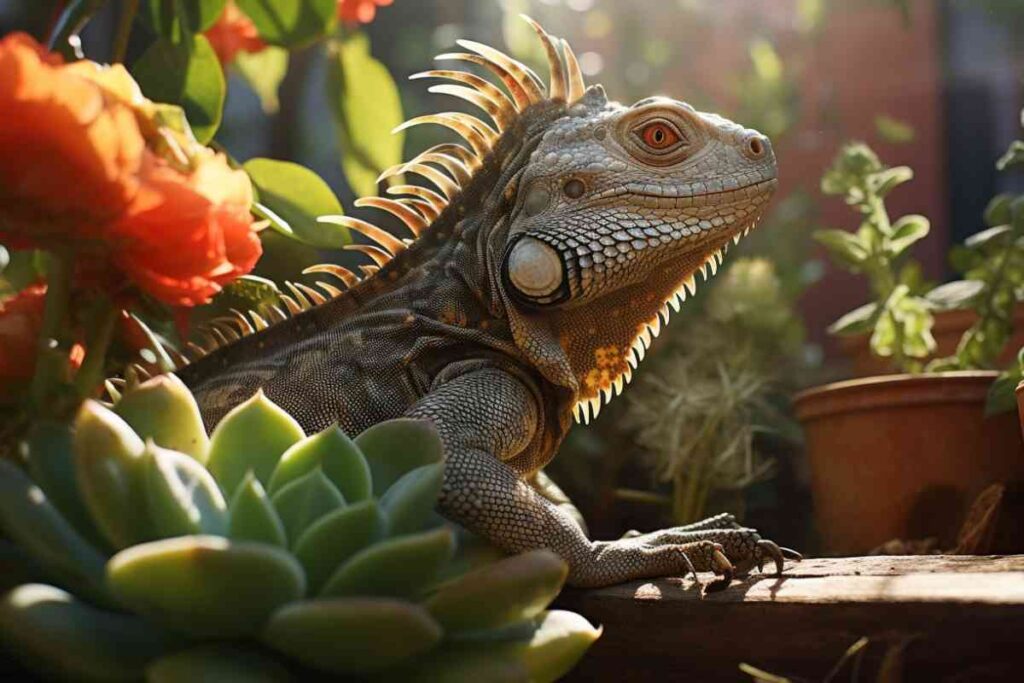
Top 5 Reptiles that Eat Succulents and What to do About It
- Desert Tortoises:
- Description: Desert tortoises are herbivorous reptiles found in arid regions. They have a domed shell and feed on various plants, including succulents.
- Damage: They can cause significant damage by consuming succulent leaves and stems, leading to stunted growth or even killing the plants.
- Ways to Get Rid of Them:
- Install physical barriers such as fences or wire mesh around vulnerable succulent beds to prevent access by tortoises.
- Deter tortoises by creating a separate feeding area with plants they prefer, diverting their attention away from succulents.
- Utilize natural deterrents such as cayenne pepper or garlic spray applied to the plants, as tortoises find the strong smell unappealing.
- Plant prickly or spiky succulent varieties that are less palatable to tortoises as a deterrent.
- If tortoise presence persists, contact local wildlife authorities or organizations for guidance on humane relocation or management options.
- Chuckwallas:
- Description: Chuckwallas are large-bodied lizards native to desert regions. They are primarily herbivorous and may feed on succulent foliage.
- Damage: Chuckwallas can strip succulents of leaves and may cause severe damage, particularly to young or small plants.
- Ways to Get Rid of Them:
- Install physical barriers such as fences or wire mesh around succulent beds to prevent access by chuckwallas.
- Use natural repellents like predator urine or predator scent deterrents around the garden perimeter to discourage their presence.
- Implement regular garden maintenance practices, such as removing debris and potential hiding spots, to discourage chuckwallas from residing in the area.
- Plant succulent varieties that have spines or thorns as a deterrent.
- If chuckwallas become persistent or pose a significant threat, consult with local wildlife authorities or reptile removal professionals for assistance.
- Iguanas:
- Description: Iguanas are large, herbivorous lizards commonly found in tropical and subtropical regions. Some species may feed on succulent vegetation.
- Damage: Iguanas can consume succulent leaves, stems, and flowers, causing significant damage and potentially killing the plants.
- Ways to Get Rid of Them:
- Install physical barriers such as fences or mesh screens around succulent beds to prevent iguana access.
- Create an iguana-friendly habitat away from succulents by planting non-preferred food sources and providing water sources.
- Utilize motion-activated sprinklers or water jets as a deterrent, as iguanas are averse to water.
- Apply natural repellents like hot pepper sprays or garlic-based solutions to the plants, as iguanas dislike the strong smell.
- If iguanas persist or become a nuisance, consult with local wildlife authorities or reptile removal experts for guidance on proper management and relocation methods.
- Geckos:
- Description: Geckos are small to medium-sized lizards found in various habitats worldwide. While some gecko species are primarily insectivorous, they may occasionally nibble on succulent foliage.
- Damage: Geckos typically cause minimal damage to succulents, with occasional nibbling on leaves or flowers.
- Ways to Get Rid of Them:
- Create an environment that is less favorable for geckos by reducing moisture levels, as they are attracted to humid areas.
- Install fine mesh screens or barriers on windows and doors to prevent geckos from entering indoor spaces.
- Eliminate potential food sources such as insects and spiders by practicing proper pest control measures.
- Make the immediate surroundings less appealing by removing hiding spots, debris, or any potential gecko shelters.
- If geckos become a persistent issue, contact local wildlife authorities or reptile removal professionals for guidance on appropriate management methods.
- Blue-Tongued Skinks:
- Description: Blue-tongued skinks are medium-sized lizards known for their distinctive blue tongues. While they are omnivorous, their diet primarily consists of plant matter, including succulent leaves.
- Damage: Blue-tongued skinks can cause damage by consuming succulent foliage, leading to defoliation and potential harm to the plants.
- Ways to Get Rid of Them:
- Install physical barriers such as fences or mesh screens around succulent beds to prevent skink access.
- Remove or relocate potential hiding spots such as rocks, logs, or dense vegetation to discourage skink presence in the garden.
- Implement natural deterrents like garlic or onion sprays on the succulents, as the strong scent may repel skinks.
- Encourage the presence of natural predators like snakes or birds of prey, which can help control skink populations.
- If blue-tongued skinks pose persistent problems, consult with local wildlife authorities or reptile management experts for assistance.
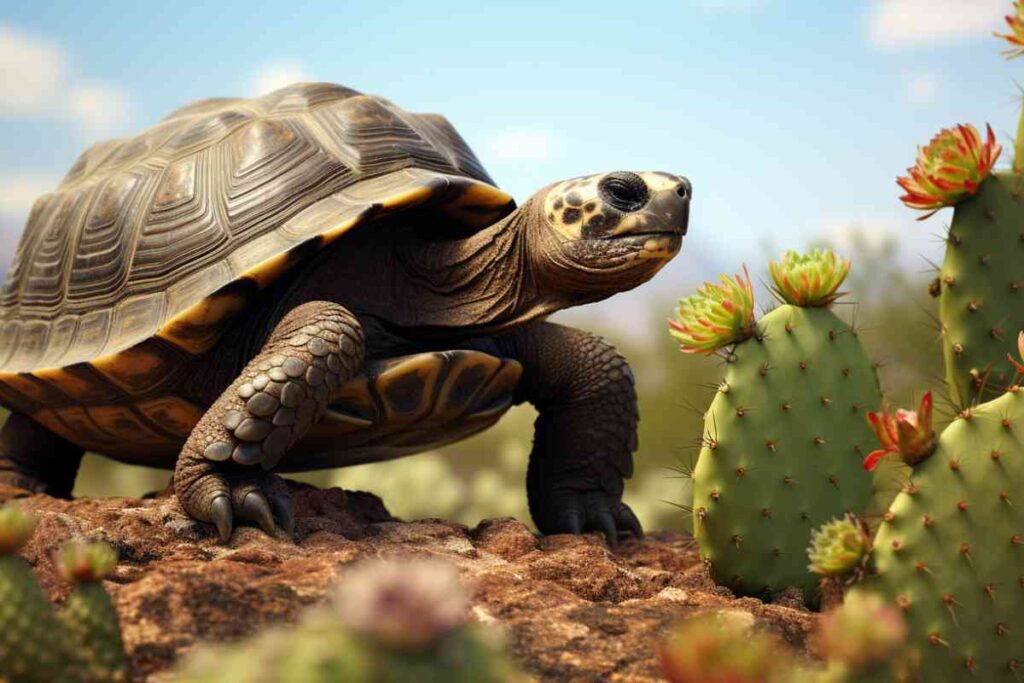
Top 5 Birds that Eat Succulents and What to do About It
- Sparrows:
- Description: Sparrows are small, sociable birds with short, stout beaks and a tendency to forage in groups.
- Damage: They may peck at succulent leaves and flowers, causing minor cosmetic damage.
- Ways to Deter Them:
- Install bird netting or mesh over vulnerable succulent beds to prevent sparrows from accessing the plants.
- Create distractions by placing bird feeders or providing other sources of preferred food away from the succulents.
- Utilize visual deterrents such as reflective tape or wind chimes to deter sparrows from the garden.
- Plant companion plants or flowers that attract beneficial insects, which in turn can attract insect-eating birds, diverting their attention from succulents.
- Implement scare tactics like motion-activated sprinklers or hanging shiny objects near the plants to startle sparrows.
- Crows:
- Description: Crows are large, intelligent birds known for their black plumage and distinctive cawing calls.
- Damage: Crows may dig or peck at succulent pots or disturb the soil around the plants, potentially uprooting them.
- Ways to Deter Them:
- Install visual deterrents like scarecrows or owl decoys to intimidate crows and discourage them from approaching the succulents.
- Create noise deterrents by using wind chimes, bells, or recordings of distress calls of crows’ natural predators.
- Cover the soil around succulent pots with gravel or rocks to make digging more difficult for crows.
- Place physical barriers like netting or mesh around the plants to prevent crows from accessing them.
- Plant taller shrubs or trees near the succulents, creating obstacles that make it less convenient for crows to reach the plants.
- Blackbirds:
- Description: Blackbirds are medium-sized birds with black feathers and a distinct yellow or orange eye-ring.
- Damage: They may peck at succulent leaves and fruits, causing cosmetic damage and potential loss of harvest.
- Ways to Deter Them:
- Install bird netting or mesh around succulent beds or fruiting succulents to prevent blackbirds from accessing them.
- Use reflective or noise deterrents like shiny objects or wind chimes to startle and deter blackbirds.
- Hang visual repellents like CDs or aluminum foil strips that create flashes of light and movement.
- Plant decoy crops or sacrificial plants away from succulents to divert blackbirds’ attention.
- Apply organic bird repellents like chili pepper spray or garlic spray to the succulents to make them less appealing to blackbirds.
- Pigeons:
- Description: Pigeons, also known as rock doves, are medium-sized birds with stout bodies and often found in urban environments.
- Damage: Pigeons can cause significant damage by pecking at succulent leaves, stripping them or damaging the entire plant.
- Ways to Deter Them:
- Install physical barriers such as bird netting or mesh around succulent beds or use scare tape or bird spikes to prevent pigeons from landing.
- Provide alternative roosting areas like birdhouses or designated perching spots away from the succulents.
- Utilize visual deterrents like predator silhouettes or hanging reflective objects to scare away pigeons.
- Apply organic bird repellents such as chili pepper spray or vinegar spray to make the succulents less appealing.
- Ensure there is no readily available food source like spilled birdseed or open garbage bins, as pigeons are attracted to food.
5. Orioles:
- Description: Orioles are medium-sized, brightly colored birds known for their vibrant plumage and melodious calls.
- Damage: Orioles may occasionally peck at succulent flowers or fruits, causing minor damage or nectar depletion.
- Ways to Deter Them:
- Install physical barriers such as bird netting or mesh around fruiting succulents to prevent orioles from accessing them.
- Create distractions by providing alternative nectar sources like hummingbird feeders away from the succulents.
- Utilize visual deterrents like shiny objects or reflective tape to startle orioles and deter them from the garden.
- Plant companion plants or flowers that attract beneficial insects, which in turn can attract insect-eating birds, diverting orioles’ attention.
- Apply organic bird repellents like bitter-tasting sprays or citrus-scented sprays to make the succulents less appealing.
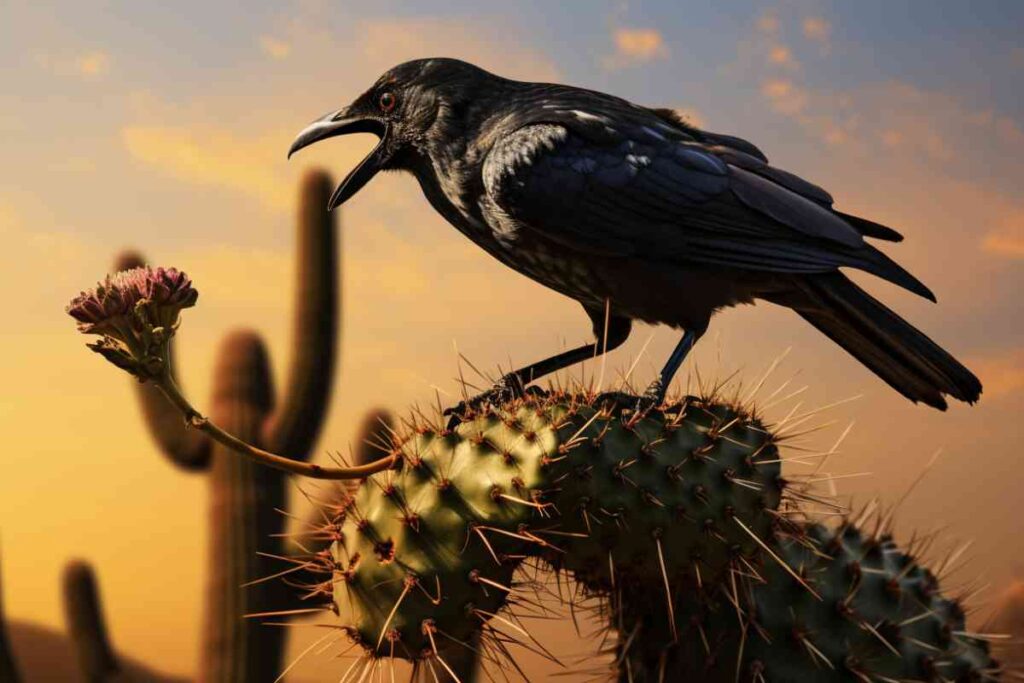
Nutritional Value of Succulents for Animals
One of the key nutritional benefits of succulents is their high water content. Animals that eat succulents can stay hydrated even in arid environments where water is scarce. Additionally, succulents are rich in a variety of vitamins and minerals that are essential for animal health. For example, many succulents are high in vitamin C, which helps to boost the immune system and promote healthy skin and bones.
In addition to their high water content and vitamin content, succulents also contain a range of other nutrients that are important for animal health. These include:
- Fiber: Many succulents are rich in fiber, which helps to promote healthy digestion and prevent constipation.
- Calcium: Some succulents are high in calcium, which is important for strong bones and teeth.
- Iron: Many succulents are also a good source of iron, which is essential for healthy blood and energy levels.
Overall, succulents offer a range of nutritional benefits that make them a valuable food source for many animals living in dry environments. Whether they are looking for hydration or essential nutrients, animals can rely on succulents to provide them with the nutrition they need to thrive.
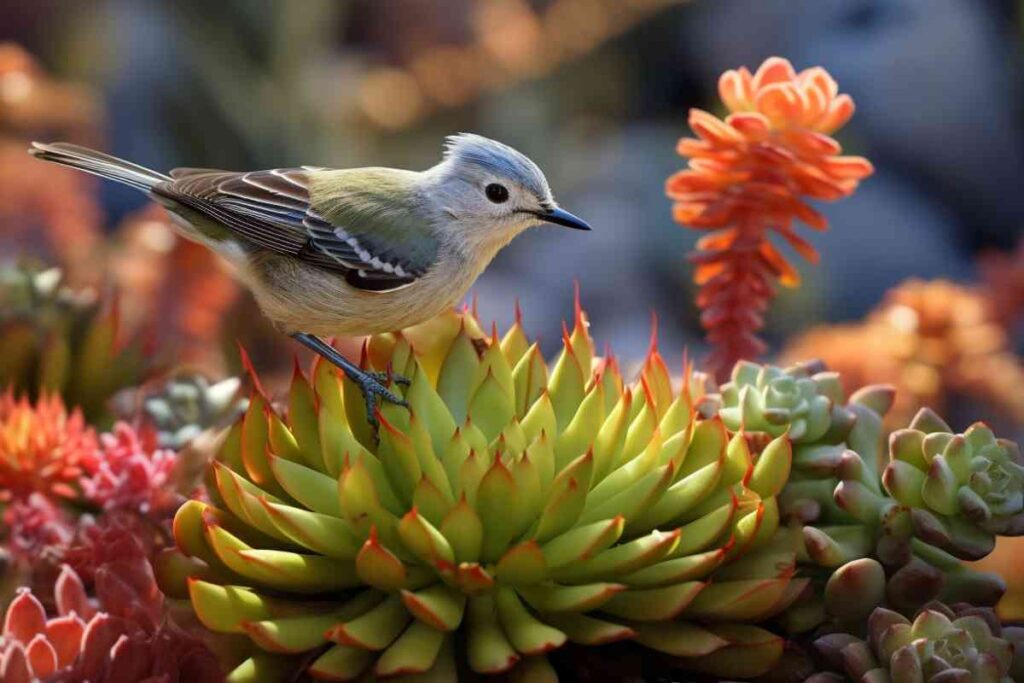
Using rocks and gravel to mulch succulents is a great way to deter many pests. These succulent rock garden ideas are perfect for making gravel and rock mulch look amazing.
Sick of dealing with animals eating your succulents? These lovely ornamental grasses are often resistant to pests, and work beautifully in a succulent gardne.
Conclusion
In conclusion, succulents are not immune to being eaten by animals. Creatures like snails, slugs, grasshoppers, spider mites, mealybugs, caterpillars, cats, rats, squirrels, and birds can feed on them. This can cause wilting, discoloration, and even death of the plant.
It is important to note that animals may be attracted to succulents because they store water, which can be a valuable resource in dry environments. To prevent animals from eating your succulents, make sure they are getting enough water and consider adding a water source nearby to divert their attention from your plants.
Frequently Asked Questions
Which animals commonly eat succulent plants?
Succulent plants are often eaten by a variety of animals, including birds, rodents, squirrels, chipmunks, snails, slugs, grasshoppers, spider mites, mealybugs, and caterpillars.
Can squirrels and chipmunks damage succulent plants?
Yes, squirrels and chipmunks can damage succulent plants. They are known to climb, dig, and chew their way through anything to get their food, including succulent plants.
What are the signs that an animal is eating my succulent leaves?
The signs that an animal is eating your succulent leaves include wilting, discoloration, holes in the leaves, and missing or damaged leaves.
Do rodents like mice and rats eat succulent plants?
Yes, rodents like mice and rats can eat succulent plants. They are known to feed on a variety of plants, including succulent plants.
Are there any animals that avoid eating succulent plants?
Some animals, such as dogs and cats, may avoid eating succulent plants after tasting them. However, it is important to make sure that your succulent plants are non-toxic to your pets.
How can I protect my succulent plants from being eaten by animals?
To protect your succulent plants from being eaten by animals, you can use natural pesticides, such as neem oil or insecticidal soap. You can also use physical barriers, such as chicken wire or mesh, to keep animals away from your plants. Additionally, you can try planting your succulent plants in containers or raised beds to make them less accessible to animals.



